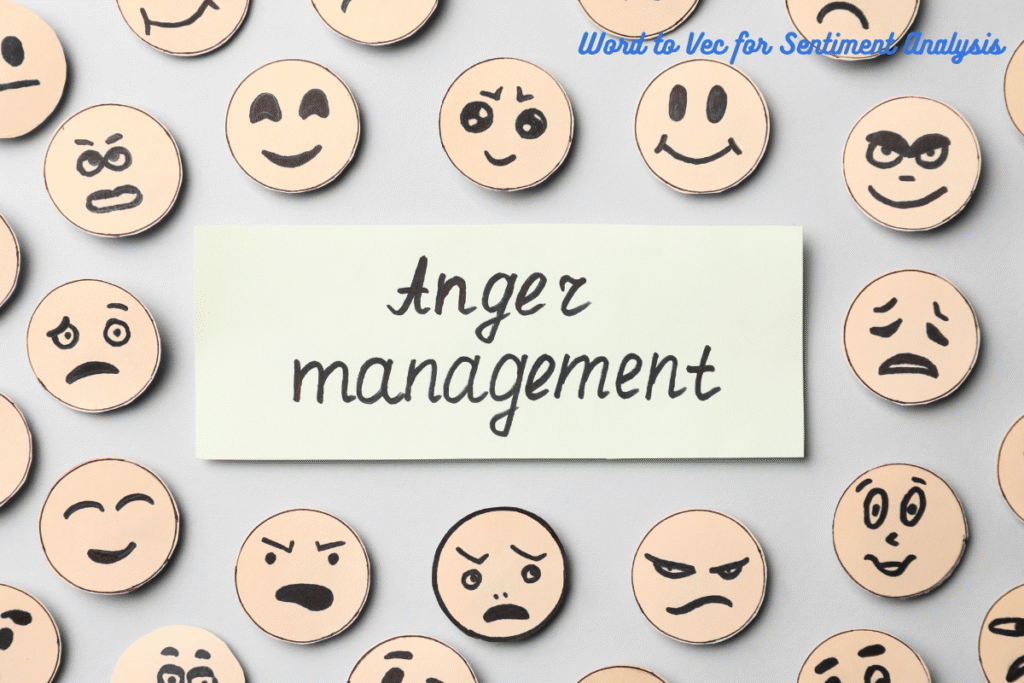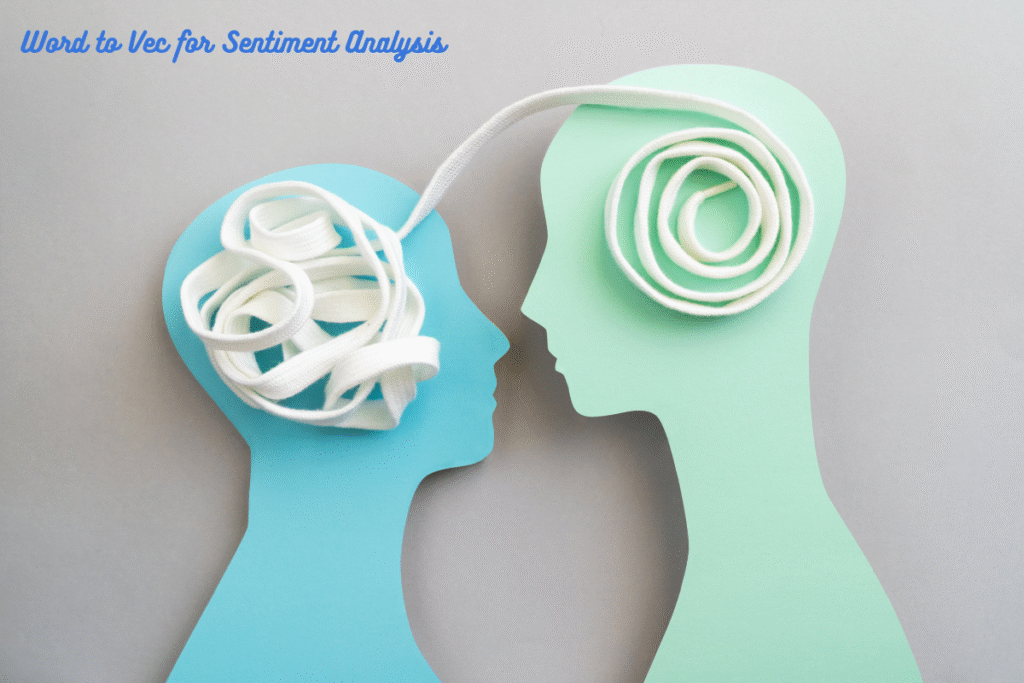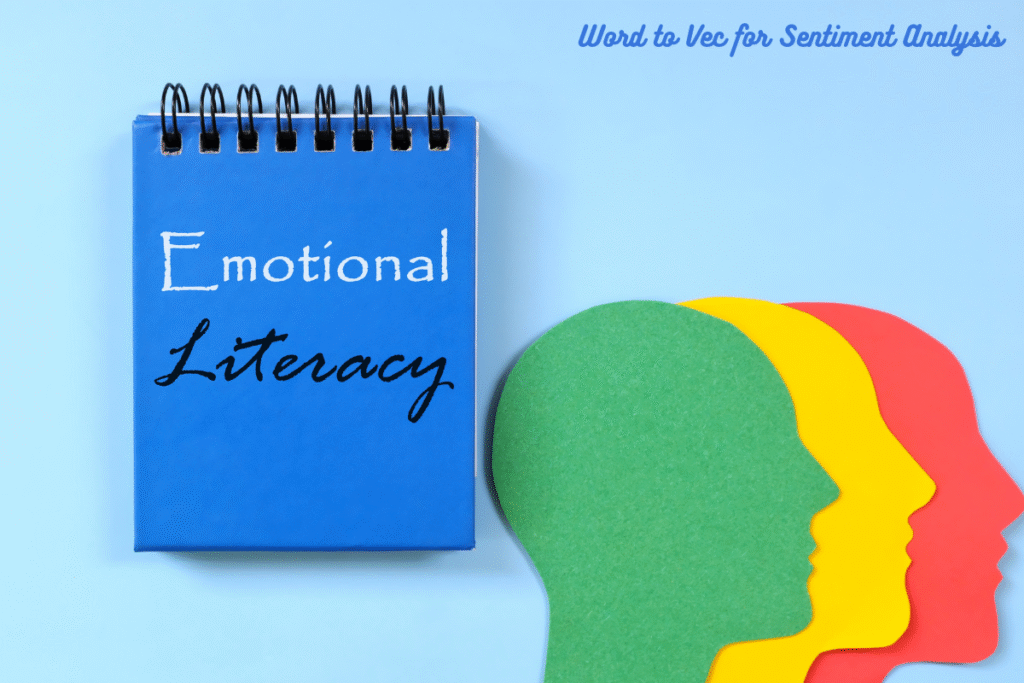Word to Vec and Sentiment Analysis: An Introduction:

Sentiment analysis is an important part of NLP that helps us understand the feelings behind text data. Word to Vec for Sentiment Analysis is a key part of this procedure. It turns words into numerical vectors that have significance.
These vectors pick up on subtle differences in context and mood, which helps models better interpret sentiment. Word to Vec for Sentiment Analysis changes text into a structured numerical form, which makes it easier to analyse customer reviews, social media, and other text sources more accurately and get deeper emotional insights.
Table of Contents
An Overview of NLP and Sentiment Analysis Applications:
Sentiment analysis is one of the main uses of Natural Language Processing (NLP), which is a set of methods for interpreting and processing human language. Word to Vec for Sentiment Analysis is very important here since it turns words into dense vectors that hold both semantic and emotional values.
By looking at how words are related to each other in huge corpora, this method lets systems figure out whether a sentiment is good, negative, or neutral. **Word vector embeddings hold social ontological relations capable of reflecting meaningful fairness assessments**, which helps improve accuracy. For instance, words like “happy” and “joy” are put close together in the vector space, which makes it easier to classify sentiments correctly. These representations also make it easier to analyse client feedback, keep an eye on social media, and manage a brand’s reputation, all of which require knowing the emotional tone.
Changing Words into Numbers for Context and Emotion:

The main idea behind “Word to Vec for Sentiment Analysis” is to change words into high-dimensional numerical vectors using models like CBOW or skip-gram. These models look at how words are used together in context windows to find semantic relationships. For example, “king” and “queen” are close in vector space, as are “sad” and “disappointed.”
This change helps algorithms understand not only the literal meaning but also emotional undertones, like empathy or joy. This approach of expressing words makes sentiment analysis more detailed, allowing algorithms to pick up on little changes in mood in text and enhance accuracy across a wide range of datasets. This makes NLP systems more sensitive and human-like.
Learning How to Vectorise in Word to Vec:
Models like CBOW and skip-gram are very important for making word representations that make sense. The main idea behind “Word to Vec for Sentiment Analysis” is to use these models to develop dense embeddings by looking at large sets of text data.
The correctness of embeddings depends on context windows, which show how much the text around a word affects its vector. This method picks up on semantic connections and emotional subtleties, which makes the models good for sentiment analysis tasks that need to pick up on little emotional cues in language
How CBOW and Skip-gram Models Work in Word to Vec:
The main architectures that **Word to Vec for Sentiment Analysis** uses are CBOW and skip-gram. CBOW predicts a target word based on the words around it. This works well for small datasets since it captures the context well. Skip-gram, on the other hand, predicts the words around a target word. This works better with larger datasets.
Both methods look at a lot of material to find patterns of words that appear together, which show how similar the meanings and feelings are. For example, “happy” and “joyful” are commonly used in the same situations, which lets the models put them near together in the embedding space. These detailed representations are important for sentiment analysis since being able to tell the difference between small emotional changes can have a big effect on the results.
How Word to Vec Finds Words That Mean the Same Thing:

For **Word to Vec for Sentiment Analysis** to work, it needs to be able to learn about semantic similarities. The models find patterns in large amounts of text data where words with similar meanings or emotional implications often show up in similar situations. For instance, “sad” and “disappointed” are near together in vector space, which shows how they are related emotionally.
This semantic clustering lets sentiment analysis systems tell the difference between good and negative feelings and spot connected emotional expressions, which makes predictions more accurate and aware of the context. Context windows are really important here. By changing their size, models can capture a wider or narrower range of contextual meaning, which makes embeddings even better for detecting subtle emotions.
Why Context Windows Are Important for Making Embeddings:
Context windows set the limits on the words around the ones used to train embeddings in “Word to Vec for Sentiment Analysis.” Smaller windows look at the immediate context and pick up on direct connections, whereas bigger windows look at the bigger picture and pick up on more abstract semantic interconnections.
When doing sentiment analysis, picking the correct window size helps the model pick up on the emotional tone and little differences—like sarcasm or irony—in different situations. When calibrated correctly, context windows let embeddings effectively show emotional and semantic relationships. This makes the model better at reliably judging sentiment, even in complicated text data like reviews or social media posts.
The Strength of Words About Feelings and Empathy in Vector Space:
Word to Vec for Sentiment Analysis turns words like “empathy” and “joy” into vectors that show how emotionally important they are. These vectors are usually close to sentiment words that are related to them in the embedding space, which helps capture subtle emotional connections.
This closeness helps models grasp and tell the difference between different emotional expressions. Using **Word to Vec for Sentiment Analysis**, you can find words with positive or negative feelings by looking at how similar they are to other words. This makes it easier to find feelings in complicated text data.
How Word Vectors Show Emotional Words:

In **Word to Vec for Sentiment Analysis**, words like “empathy” and “joy” are put into high-dimensional spaces where words with comparable emotional connotations group together. These representations are learnt by looking at how often words that are related to each other appear together in big collections of text.
For instance, “empathy” is typically found among terms like “compassion,” “understanding,” or “kindness,” which makes a semantic cluster of words that have to do with caring. “Joy” might also be near to terms like “happiness” and “celebration.” This closeness not only captures the semantic complexity but also the emotional overtones, which helps models better understand how people feel about text.
Detecting Sentiment with Vector Similarity:
Word to Vec for Sentiment Analysis uses vector similarity metrics, like cosine similarity, to find words that have comparable emotional polarities. When looking at sentiment, the model looks at the vectors of new words and compares them to known positive or negative seed words, such as “happy” or “sad.”
If a word’s vector is near to “joy” or “anger,” the algorithm puts it in that group. This method makes it possible to detect sentiment in a flexible and contextual way, especially for words and phrases that aren’t clearly labelled but are close to each other in terms of emotion in the vector space. It makes sentiment analysis strong and able to work with a wide range of texts.
The Seven Key Words Approach to Mapping Keywords to Sentiment:
In “Word to Vec for Sentiment Analysis,” picking seven strong words, such “hope,” “love,” “anger,” “sadness,” “trust,” “fear,” and “happiness,” is a good way to start figuring out how people feel.
These words serve as anchors in the vector space, which helps models understand complex emotional states and how they relate to other words. The system can sort and understand a wide range of emotional expressions by looking at how the vectors of these key words relate to nearby terms.
Choosing Words That Will Have an Effect for Sentiment Analysis:

Picking the proper seven words in “Word to Vec for Sentiment Analysis” is quite important because each one stands for a main emotional or sentiment category. Words like “hope” and “love” show good feelings, while words like “anger” and “sadness” show bad feelings. “Trust” and “fear” let you tell the difference between feeling safe and feeling unsafe, while “happiness” means being healthy overall. These words serve as reference points or anchors in the embedding space, allowing models to place many comparable words around them based on their context.
The vectors of these important words hold a lot of meaning that is related to other words. For example, “hope” may be close to “optimism,” “dream,” or “aspiration,” while “anger” may be close to “frustration” or “resentment.” By looking at how these vectors are related to each other, sentiment analysis becomes more complex, which helps us understand the emotional content of texts better.
Capturing Subtle Emotions Through Vector Relationships:
The strength of **Word to Vec for Sentiment Analysis** comes from how the vectors of these important words convey little emotional differences. For instance, the vector for “trust” might be close to words like “confidence” and “faith,” which show a sense of security. On the other hand, “fear” might be close to “anxiety” and “worry.”
These connections help the model find not only broad positive or negative feelings but also more complex emotional states. When words are used in different situations, their distance from these seven key vectors can give us an idea of their sentiment. For example, “hope” and “despair” are two different emotions. This method makes sentiment analysis more accurate and deep, especially in texts that are varied and complex.
Word Vectors for Visualising Sentiment:

In “Word to Vec for Sentiment Analysis,” seeing how words with strong emotions relate to each other helps make sense of complicated emotional patterns. t-SNE and PCA are two methods that show groups of words with similar meanings by projecting high-dimensional word vectors into two or three dimensions.
This picture makes it easy to see how words like “joy” and “happiness” fit together. This kind of clarity makes it easier to understand the emotional structure of text data, which makes sentiment analysis more clear and useful for things like monitoring social media and analysing consumer comments.
How to See Word Embeddings:
In **Word to Vec for Sentiment Analysis**, high-dimensional word vectors are made smaller using advanced visualisation methods like t-SNE (t-distributed stochastic neighbour embedding) and PCA (principal component analysis). These techniques show us how sentiment-related words group together in two or three dimensions, showing how they are related in meaning and emotion.
For instance, “happiness,” “joy,” and “delight” might all be close together, showing how closely they are connected emotionally. “Anger” and “frustration,” on the other hand, might be in a different group. Researchers and analysts can better understand the emotional landscape stored in the embeddings with the help of these kinds of visualisations. They show how sentiment words are grouped based on their similarities in context.
Showing Groups of Sentiment Words:
Using **Word to Vec for Sentiment Analysis**, the visualisation of word embeddings shows how sentiment terms naturally group together in the vector space. These clusters show that words that have positive feelings, like “hope” and “trust,” are close to each other, whereas words that have negative feelings, like “sadness” and “anger,” are in separate groupings.
This clustering not only proves that the embeddings are good, but it also helps make sentiment models that are easier to understand. Researchers can better comprehend emotional aspects, find words that might have been mislabeled, and increase the accuracy of their models by looking at these patterns graphically. So, visualisation connects quantitative analysis with human intuition, which makes it easier to understand complicated emotional data.
Uses: Improving Sentiment Models using Word to Vec:
In “Word to Vec for Sentiment Analysis,” using semantic closeness between sentiment words makes the model much more accurate. By looking at how words that are similar group together in vector space, models can better recognise the differences between emotional tones.
Also, **Word to Vec for Sentiment Analysis** lets you do vector math, such “king” – “man” + “woman” “queen,” to find deeper emotional and relational connections. These methods improve sentiment categorisation by capturing complicated emotional connections, which makes sentiment analysis systems more accurate and aware of the context
Semantic Proximity for Better Classification Accuracy:

The main strength of **Word to Vec for Sentiment Analysis** is that it uses the semantic closeness of words that have similar feelings. Words like “happy,” “joyful,” and “content” readily group together in the vector space, which shows how similar their emotional states are. **Leverages Large Language Models to Improve NLP Applications**, which enhances this process. When the model comes across new or unclear words, being close to these clusters helps it figure out the sentiment more effectively.
For instance, if a review has the word “delighted,” its vector will be close to “happy,” which will help the system figure out the sentiment appropriately. This method makes sentiment models more reliable overall and less likely to make mistakes, especially when dealing with subtle or slang phrases that indicate feelings in an indirect way.
Using Vector Arithmetic to Figure Out Emotional Relationships:
**Word to Vec for Sentiment Analysis** also uses vector arithmetic to find and understand emotional connections that may not be clearly labelled. The word “king” is a typical example. “Man” + “woman” = “queen,” which shows how semantic vectors can show interactions between people of different genders or roles.
You can also look at emotional comparisons like “hope” and “sadness” as “hopefulness.” This skill lets models figure out changes in sentiment or related emotional states and grasp how different emotions interact with each other in text. Adding these kinds of semantic linkages makes it easier for the algorithm to understand subtle emotional cues and makes sentiment analysis more like how people think and act in real life.
Conclusion: Using Word to Vec to Get Emotional Insights:
In **Word to Vec for Sentiment Analysis**, vectorisation makes it much easier for us to grasp the emotional content of text by capturing subtle emotional links. This method makes it easier to find emotions by showing little changes and links in how people express themselves.
Combining **Word to Vec for Sentiment Analysis** with more complex models like transformers looks very promising for the future. These kinds of integrations can make sentiment analysis more nuanced and aware of the context, which can help us understand how people feel in a wider range of situations, such as on social media, in customer feedback, and in mental health evaluations.
Summarising How Vectorisation Improves Understanding of Emotions:

Word to Vec for Sentiment Analysis uses vectorisation to turn words into dense numbers that hold their emotional and semantic connotations. This approach lets models see how words are related, like how “joy” and “happiness” are close together in vector space.
This level of detail helps with sentiment classification, especially when it comes to picking up on little emotional cues and complicated expressions. Vectorisation also lets you measure changes in emotion in a text and find feelings that may not be directly articulated. These improvements make sentiment analysis systems more advanced and human-like, allowing them to understand emotions more profoundly and accurately.
Future Potentials: Using Word to Vec and Transformers Together:
The future of “Word to Vec for Sentiment Analysis” is in combining it with newer language models like BERT and GPT, which are called transformers. These models are great at getting to the heart of the matter, and when used with **Word to Vec**, they can help you grasp emotional content on multiple levels.
This synergy can help models grasp emotion not just from single words, but also from tone, context, and intention. Because of this, sentiment analysis can be more accurate, detailed, and useful in real-time applications like emotional AI and mental health monitoring. These kinds of mixed methods are likely to help us understand human emotions communicated through language in a deeper and more complete way.
People Also Ask:
How does Word to Vec for Sentiment Analysis enhance the detection of emotions like empathy and joy in textual data?
This question asks how “Word to Vec for Sentiment Analysis” can pick up on more subtle sensations like empathy and joy, which makes sentiment analysis more nuanced and useful.
Which are the 7 key words that can optimize Word to Vec for Sentiment Analysis in identifying emotional tones?
This is about finding important keywords that, when added to **Word to Vec for Sentiment Analysis**, make it better at recognising certain emotions and feelings.
In what ways can Word to Vec for Sentiment Analysis be used to analyze customer feedback for emotional depth and authenticity?
This looks learns how to use “Word to Vec for Sentiment Analysis” to get real emotional responses from reviews and feedback to help businesses make better decisions.
What are the limitations of Word to Vec for Sentiment Analysis in accurately interpreting complex emotions and sentiments?
This inquiry looks into the problems and possible flaws of **Word to Vec for Sentiment Analysis** when it comes to dealing with layered or unclear emotional expressions.